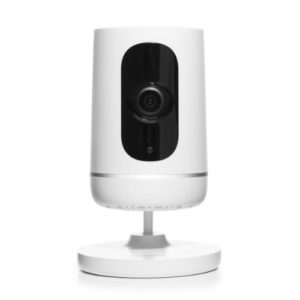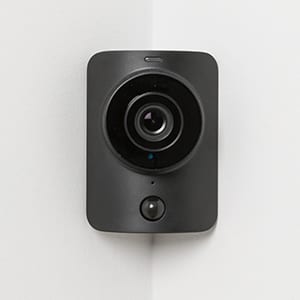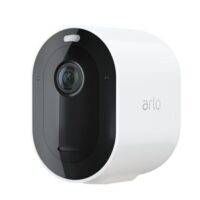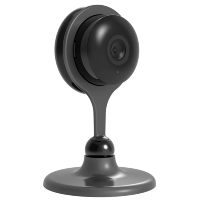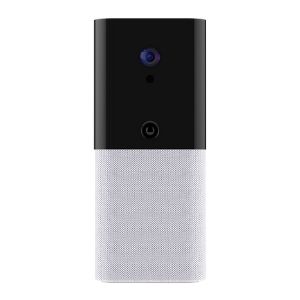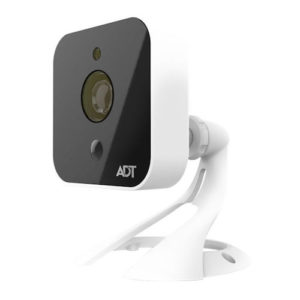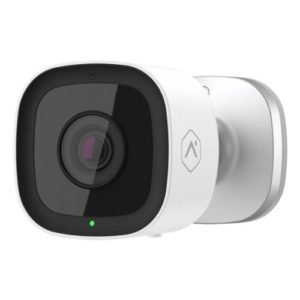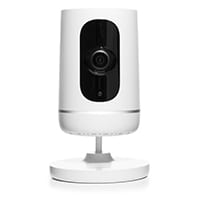We’ve picked the best home security cameras based on image quality, price, smart features, and more.
Best Home Security Cameras of 2022
Best security camera reviews
1. Vivint Indoor Camera: Luxury smart home pick
Vivint has a reputation for innovative home security solutions, and the Indoor Camera (formerly known as the Vivint Ping Camera) doesn’t disappoint.
This home security camera stands out with customized notifications, video analytics, and seamless integration with the Vivint app and smart home platforms from Google and Amazon. And if you’ve got kids or parents at home, you’ll love the one-touch callout that lets family members call your cellphone right from the camera with the touch a button.
But you can't buy this camera on its own—you need to add to a full Vivint home security system.
See all the home security cameras from this company in our Vivint cameras review.
2. SimpliSafe Indoor Camera: Reader favorite brand
SimpliCam is a great basic DIY solution with a handy stand-out feature: its steel privacy shutter. You can use the SimpliSafe app to close the shutter when you don’t want the camera filming.
If you need an outdoor camera, SimpliCam has an outdoor kit for $19.99 that morphs this indoor camera into a weather-resistant camera.
This camera's downsides are its video resolution (just 720p vs. 1080p for other cameras), and its 120° field of view doesn't match the 160° many cameras offer.
But you can't buy this camera on its own—you need to add to a SimpliSafe home security system.
Learn more in our complete SimpliSafe Simplicam review.
3. Arlo Pro 3: Best overall wireless pick
The Arlo Pro 3 is a SafeWise favorite. It builds on the previous two versions by introducing 2K video quality and a bright spotlight for color night vision video. It also tops our list of the best wireless security cameras.
We're fans of its wire-free installation, quick setup, and sensitive motion detector. Plus, it works inside or out.
The biggest drawback is the investment. You need to purchase a base station in addition to two cameras, which makes the up-front cost heftier than other cameras.
Read our full Arlo security camera review to get all the details.
4. Cove Indoor Camera: Customer-focused pick
The Cove Indoor Camera trades weatherproofing for smart detection that uses AI to spot humans, baby cries, and fewer false alarms. We love the camera's human detection for tracking when a person sets off the motion sensor.
Although this camera's 110º field of view is narrower than average, it works well enough indoors. It's wired, but that means you don't need to monitor battery levels.
But you can't buy this camera on its own—you need to add to a Cove home security system. if you want a standalone security camera with arguably better features, you might consider checking out the Wyze Cam v3.
Learn more in our complete Cove Cameras review.
5. Abode Iota: Smart home compatible pick
The Abode Iota box is jam-packed with features: HD camera, motion sensor, 93-decibel siren, two-way audio, and person detection (with $6/mo. subscription).
It's one of the most compatible security cameras on the market, integrating with around 160 smart home products. It also has the easiest setup you could ask for: place it on a table and plug it in.
But the Iota falls short when it comes to video and audio quality. The image often lags and the audio can sound staticky at times. It also has a limited viewing angle.
This camera is built into Abode's home security system. Read our full Abode review for more details.
Learn more about smart devices that can be connected to Abode in our Abode equipment and compatibility guide.
6. ADT Outdoor Camera: Pro monitoring pick
The ADT Outdoor Security Camera offers infrared night vision, 30-second clips with a 5-minute cool-off period, and 720p resolution (not the best). Its weatherproof design can withstand temperatures between -40°F and -158F°, with a built-in heater that will kick in if the temperature drops below 42°F.
It also uses passive infrared (PIR) sensors that detect body heat rather than light. These motion sensors can detect movement up to 15 feet away, but the outdoor camera has the narrowest field of vision of ADT’s camera lineup, with only a 95° viewing angle.
But you can't buy this camera on its own—you need to add to a ADT home security system.
Learn more in our complete ADT Cameras review.
7. Frontpoint Outdoor Camera: Whole-property pick
We like the Frontpoint Outdoor Camera's impressive 40-foot night vision range, which helps produce bright, clear videos in total darkness. The camera also works well in below-freezing temperatures as well as temperatures up to 113°F.
Aside from that, its price tag and its 117º field of view make it average among security cameras.
It's not as affordable as wireless outdoor cameras from the likes of Ring and Arlo, but it's cheaper than similar cameras from Brinks, Google Nest, and Vivint.
But you can't buy this camera on its own—you need to add to a Frontpoint home security system.
Learn more in our complete Frontpoint cameras review.
Security camera FAQ
There are a lot of security cameras to choose from—many work well in a compatible home security system or as stand-alone units. Understanding the differences will help you find one that fits your needs. Here are five kinds of security cameras you're likely to encounter.
Indoor security cameras
Select an indoor camera to watch what’s happening inside your home, particularly one with two-way audio. You can check in with kids after school, tell Rover to get off your favorite chair, or scare the daylights out of an intruder who doesn’t belong in your home (plus you’ll have their picture, to boot!).
Outdoor security cameras
An outdoor camera relies on a high weatherproof rating that stands up to the elements and drastic changes in temperature. Another big feature is night vision. You might also consider a camera with a built-in motion-activated light—all the better to scare you with, my dear!
Doorbell cameras
A doorbell camera is essentially an outdoor camera for watching over your front porch. A video doorbell uses two-way audio so you can talk to guests and are a good way to make sure packages don’t walk off unnoticed.
Wireless security cameras
As a concept, wireless cameras are confusing. “Wireless” can either mean cameras with a Wi-Fi connection or that they run off a battery. We lean toward cameras that are 100% wire-free, with both Wi-Fi and a wireless power source. But we include some of both types in our wireless camera roundup.
Monitored security cameras
Security cameras in a monitored security system usually have the same features and options as stand-alone units. But you can tap into the expertise of the home security company to pick the right one. They work with your security system, so there's always an extra set of eyes looking out for trouble 24/7.
Beware of using an indoor camera to look outside through a window. They can’t capture images after dark because the night vision LEDs reflect off the glass, blinding the camera.
Here are some important features to consider when buying home security cameras:
Video resolution
Resolution directly affects the quality of the home security footage your camera produces. A clear image provides crucial details to help identify faces, vehicles, and items in a recording. At a minimum, choose a camera with 720p resolution, but we suggest 1080p or higher.
Field of view
Field of view refers to how much area a camera sees through its lens. It affects how many cameras you need and where you should place them. In general, choose a camera with a field of view that's at least 110º, though wider angles than this are usually better.
Motion detection
Most security cameras offer motion alerts to help prevent break-ins and keep deliveries safe. You receive notifications when a camera observes movement, so you can react appropriately. Choose a motion sensor camera with many settings to get the most from its motion detection.
Night vision
Security camera footage that is too dark to make out any details is practically useless. The distance your camera can see in low- to no-light situations impacts its effectiveness after the sun sets. To cover your bases, choose a camera with an adequate night vision range.
Two-way audio
Cameras with two-way communication have a microphone and speaker for interacting with people or pets on the other end. Two-way talk effectively turns your home security camera into an intercom for addressing a delivery driver or checking in on the kids after school.
Pan and tilt
A pan-and-tilt camera has motors that allow you to reposition the camera's lens remotely. This feature records a larger area than a static camera and reduces the number of cameras you need to observe a particular area.
Some pan-and-tilt cameras use smart motion detection to follow action in a room automatically, whether it’s a pet racing around the living room or a youngster toddling toward trouble.
Absolutely. Home security cameras allow you to more effectively watch over your home in two primary ways:
- Deter: A surveillance camera in a highly visible location can make burglars think twice about attempting to enter your home.
- Describe: Security cameras can collect information about burglars and the items they take. This makes it easier to file police reports and insurance claims.
The best part is that you choose how much to spend on security cameras for your home.
In 2019, burglaries cost Americans around $3 billion in property losses, for an average loss of $2,661 per offense.¹ With so much money on the line, we were surprised to find that only 25% of Americans use a security camera to protect their property and even fewer (24%) use a home security system.²
See which cities in America have the most burglaries in our exclusive report below.
If a camera costs so much that you can no longer afford the valuables you’re trying to protect, then it doesn’t serve a purpose.
Fortunately, we live in an age where practically everyone can afford security cameras. In fact, many cheap security cameras cost less than $50 while providing HD video, motion detection, smartphone apps, and two-way audio. They're even cheap enough that you can buy multiple cameras.
With more expensive cameras, you can expect better features and stronger customer support. Ultimately, it's your choice how much you want to invest for a certain level of security.
Monitored security cameras are more expensive because they come as part of a professionally-monitored security system that watches your home 24/7.
Most of the time. Modern security cameras use Wi-Fi for five tasks:
- Streaming live video
- Storing video footage in the cloud
- Mobile device controls and alerts
- Two-way audio
- Communication with smart home devices
The majority of consumer security cameras use Wi-Fi to connect to your home network, but some models use cables to connect to your internet router or a DVR for security cameras. We recommend using Wi-Fi security cameras since they are typically the easiest kind to install.
If you have an internet data usage cap, make sure you understand how your security camera(s) could impact your monthly bill. You should also verify that your router can handle the extra devices and output.
Many of the best security camera systems also help turn your house into a smart home. Security cameras often integrate with a smart home hub like Amazon Echo or Google Home.
This can give you a huge home security advantage—the ability to remotely control lights, door locks, and your security cameras. You can also program your system to boost security measures when you’re out of town or during the holidays when lots of packages arrive.
Our approach
We've reviewed many cameras across a variety of price points and types so it can get a bit overwhelming to collect all of those in one place. Instead, we selected our favorite cameras from all of those other lists to give you a broad overview of what to look for in a security camera.
Our conclusions about each camera come from years of experience, thousands of customer reviews, manufacturer specifications, and—in many cases—physical testing. You can learn more about we review products by checking out our methodology.
Related articles
Sources
- FBI, Unified Crime Reporting, “2019 Crime in the United States, Burglary,” October 2020. Accessed January 25, 2021.
- SafeWise, “The State of Safety in America 2020,” March 2020. Accessed January 25, 2021.
Disclaimers
*Product prices and availability are accurate as of the date/time indicated and are subject to change. Any price and availability information displayed on Amazon at the time of purchase will apply to the purchase of this product. Safewise.com utilizes paid Amazon links.
Certain content that appears on this site comes from Amazon. This content is provided “as is” and is subject to change or removal at any time.
†Vivint Indoor Camera not sold separately; requires a Vivint home security system.
‡Google, Google Nest, Google Assistant, Google Home, and other related marks are trademarks of Google LLC.
